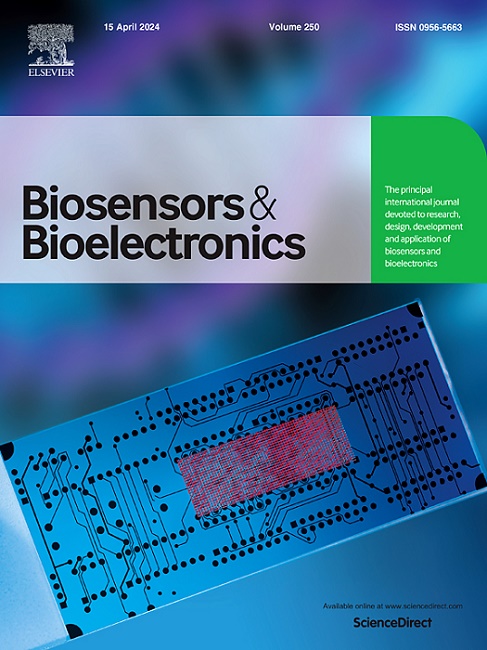利用高电子迁移率晶体管生物传感器结合夹板连接技术对单核苷酸分辨率的miRNA进行超灵敏检测
IF 10.5
1区 生物学
Q1 BIOPHYSICS
引用次数: 0
摘要
由于缺乏准确、灵敏和快速的生物液体检测方法,microrna作为临床癌症生物标志物的使用受到阻碍。在这里,我们报告了一种生物传感方法spligg - hemt,它将RNA夹板连接反应与AlGaN/GaN高电子迁移率晶体管生物传感器相结合,用于超灵敏的miRNA检测。在该系统中,HEMT作为一个高效的电压放大器来提高检测灵敏度,而夹板连接反应确保了对单核苷酸突变的精确识别。通过检测miRNA-21, SpLig-HEMT生物传感器在30分钟内实现了10−18 M的异常检测极限,动态范围为10−18 M至10−13 M。此外,SpLig-HEMT生物传感器能够直接分析血清样本,有效区分健康个体和卵巢癌患者。这项研究解决了miRNA检测的关键挑战,并提出了一种有前途的癌症诊断和预后工具。本文章由计算机程序翻译,如有差异,请以英文原文为准。

Ultrasensitive detection of miRNA with single-nucleotide resolution using a high-electron-mobility transistor biosensor combined with splint-ligation
The use of microRNAs as clinical cancer biomarkers is hindered by the absence of accurate, sensitive and rapid assays for their detection in biofluids. Here we report a biosensing approach, SpLig-HEMT, that combines an RNA splint-ligation reaction with an AlGaN/GaN high-electron-mobility transistor biosensor for ultrasensitive miRNA detection. In this system, HEMT functions as a highly effective voltage amplifier to enhance detection sensitivity, while the splint-ligation reaction ensures precise discrimination of single-nucleotide mutations. By detecting miRNA-21, the SpLig-HEMT biosensor achieves an exceptional limit of detection of 10−18 M within 30 min, with a dynamic range from 10−18 M to 10−13 M. No detectable response is observed for one-mismatch miR-21. Furthermore, the SpLig-HEMT biosensor enables direct analysis of blood serum samples, effectively distinguishing between healthy individuals and patients with ovarian cancer. This study addresses critical challenges in miRNA detection and presents a promising tool for cancer diagnosis and prognosis.
求助全文
通过发布文献求助,成功后即可免费获取论文全文。
去求助
来源期刊

Biosensors and Bioelectronics
工程技术-电化学
CiteScore
20.80
自引率
7.10%
发文量
1006
审稿时长
29 days
期刊介绍:
Biosensors & Bioelectronics, along with its open access companion journal Biosensors & Bioelectronics: X, is the leading international publication in the field of biosensors and bioelectronics. It covers research, design, development, and application of biosensors, which are analytical devices incorporating biological materials with physicochemical transducers. These devices, including sensors, DNA chips, electronic noses, and lab-on-a-chip, produce digital signals proportional to specific analytes. Examples include immunosensors and enzyme-based biosensors, applied in various fields such as medicine, environmental monitoring, and food industry. The journal also focuses on molecular and supramolecular structures for enhancing device performance.
 求助内容:
求助内容: 应助结果提醒方式:
应助结果提醒方式:


